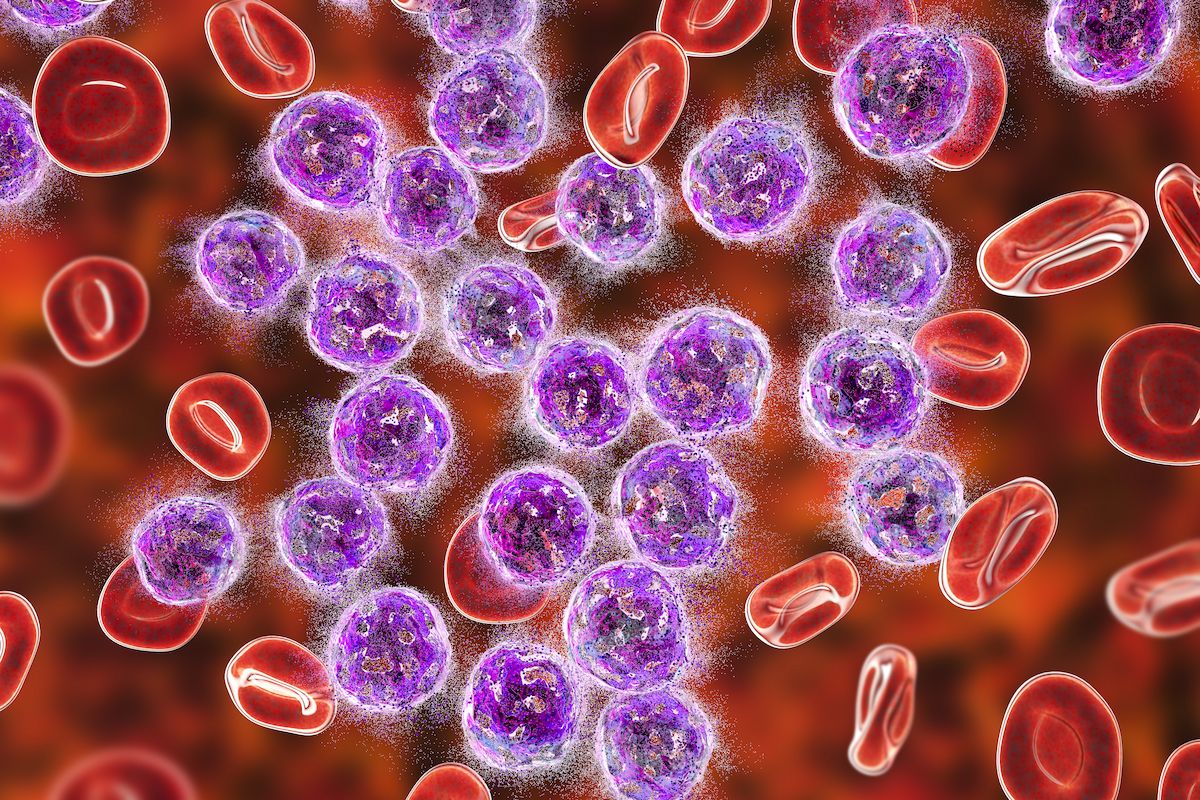Venetoclax/Azacitidine Yields Sustained Survival in AML
Data from the phase 3 VIALE-A trial showed continued responses during long-term follow-up for patients with newly diagnosed acute myeloid leukemia treated with venetoclax/azacitidine.
“Long-term follow-up of the VIALE-A trial continues to demonstrate a favorable risk/benefit profile for venetoclax/azacitidine in patients with untreated AML who are ineligible for intensive chemotherapy due to older age or comorbid conditions,” according to the study authors.

Long-term survival improved with the use of venetoclax (Venclexta) plus azacitidine (Vidaza) for patients with newly diagnosed acute myeloid leukemia (AML), according to results from the phase 3 VIALE-A trial (NCT02993523) published in the American Journal of Hematology.
The median overall survival (OS) was 14.7 months (95% CI, 11.9-18.7) in the combination arm and 9.6 months (95% CI, 7.4-12.7) in the placebo plus azacitidine arm (HR, 0.58; 95% CI, 0.47-0.72; P <.001). At 24 months, the estimated OS rate was 37.5% (95% CI, 31.8%-43.3%) vs 16.9% (95% CI, 11.2%-23.5%) in each respective arm.
“Long-term follow-up of the VIALE-A trial continues to demonstrate a favorable risk/benefit profile for venetoclax/azacitidine in patients with untreated AML who are ineligible for intensive chemotherapy due to older age or comorbid conditions,” the study authors wrote.
Patients were randomly assigned 2:1 to either the combination or placebo arm. Venetoclax or placebo was given orally once daily at 100 mg on day 1, 200 mg on day 2, and 400 mg on days 3 to 28 with continuation for subsequent cycles. Azacitidine was given intravenously or subcutaneously at 75 mg/m2 on days 1 to 7 of each 28-day cycle.
The primary end point was OS, with secondary end points being complete response (CR), CR with incomplete hematologic recovery (CRi), and CR with or without partial hematologic recover (CRh).
A total of 433 patients were enrolled, with 431 included in the intent-to-treat population, encompassing 286 in the combination arm and 145 in the placebo arm. The median follow-up was 43.2 months, and 21 patients remained on treatment in the combination arm. Following treatment, 3 patients received a stem cell transplant.
Patients with IDH1/2 or FLT3 mutations were assessed in a prespecified subgroup analysis. The median OS for those with an IDH1/2 mutation was 19.9 months (95% CI, 12.2-27.7) in the venetoclax/azacitidine arm and 6.2 months (95% CI, 2.3-12.7) in the placebo arm (HR, 0.31; 95% CI, 0.19-0.52; P <.001). Patients with IDH1 mutations had a median OS of 10.2 months (95% CI, 2.3-25.1) vs 2.2 months (95% CI, 1.1-5.6; HR, 0.28; 95% CI, 0.12-0.66; P = .002). For those with an IDH2 mutation, the median OS was 27.5 months (95% CI, 16.4-36.9) in the combination arm and 13.0 months (95% CI, 3.8-14.9) in the placebo arm (HR, 0.30; 95% CI, 0.16-0.57; P <.001).
A CR was observed in 38.8% of patients (95% CI, 33.1%-44.7%) in the combination arm vs 17.9% (95% CI, 12.1%-25.2%) in the placebo arm (P <.001). CR/CRi rates were 66.8% (95% CI, 61.0%-72.2%) vs 29.0% (95% CI, 21.7% vs 37.1%) between both arms (P <.001). The CRh rates were similar between arms.
The median duration of response (DOR) for CR was 22.1 months (95% CI, 16.7-27.0) in the combination arm and 13.4 months (95% CI, 10.3-15.1) in the placebo arm. The median DOR for CR/Cri was 18.2 months (95% CI, 13.6-23.1) vs 10.7 months (95% CI, 5.0-15.1) between both arms, respectively.
Event-free survival (EFS) was consistent with previous analysis. In the combination arm, the median EFS was 9.9 months (95% CI, 8.4-11.8) vs 7.4 months (95% CI, 5.6-9.5) in the placebo arm (HR, 0.58; 95% CI, 0.470-0.726; P <.001).
Minimal residual disease (MRD) was evaluable in 42% of patients with CRi responses in the venetoclax/azacitidine arm vs 31% in the placebo arm. Of note, 25% of patients in the combination arm had poor-risk cytogenetics, and 26% had secondary AML. IDH1/2 mutations were observed in 33% of patients, NPM1 in 33%, FLT3 in 19%, and TP53 in 13%.
Progressive disease or morphologic relapse was observed in 52% of patients with CR/CRi in the combination arm and 74% in the placebo arm, with 42% and 48% receiving subsequent therapy.
A total of 283 patients in the venetoclax/azacitidine arm were included in the safety analysis compared with 144 in the placebo arm. After a median of 43.2 months of follow-up, there were no new safety signals identified. Grade 3 or higher treatment-emergent adverse effects (TEAEs) between both arms included thrombocytopenia (46% vs 40%), neutropenia (43% vs 29%), and febrile neutropenia (43% vs 19%).
Treatment discontinuation due to TEAEs occurred for 30% of patients in the combination arm and 22% in the placebo arm. Additionally, 360 patients died for any reason. TEAEs leading to death occurred in 25% of patients in the combination arm and 22% in the placebo arm. A total of 6 patients died while in CR/CRi, with 4 from infections, and 2 from other reasons.
Reference
Pratz KW, Jonas BA, Pullarkat V, et al. Long-term follow-up of VIALE-A: venetoclax and azacitidine in chemotherapy-ineligible untreated acute myeloid leukemia. Am J Hematol. Published online February 11, 2024. doi:10.1002/ajh.27246